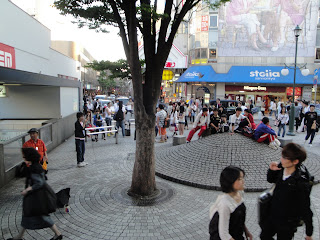Blake Foster
OVERVIEW:
For this presentation I wanted to explain the development of Japanese popular music in regards to Western influence. The reason I want to study is that music plays an important role in human lives and studying its growth and influence can reveal a lot about society during certain periods.
PERIOD FROM 1956-59:
After the end of World War II, the bans on foreign music that had existed since the rise of militarism in the 1930s was lifted, and the music that was popular with American soldiers who were occupying post-war Japan created a large influence on Japanese music and society. Jazz became popular in the postwar climate, but the real root of Japanese rock lies in Country and Western music, particularly Rockabilly, one of the earliest forms of rock and roll music.
"Rock Around the Clock" by Bill Haley and His Comets and "Heartbreak Hotel" by Elvis Presley were some of the first major American pop hits in Japan.
Around this time Japanese artists began to cover many foreign songs with Japanese lyrics. It would be from here that elements of Western pop entered Japanese song writing.
PERIOD FROM 1960-63:
The development of Japanese pop music increased during this period, particularly when Sakamoto Kyu, an Elvis fan, wrote the song "Ue Wo Muite Arukou" which became a hit in the United States under the song name "Sukiyaki". This song was the first Japanese song to appear on American record charts. It is important to note this period because a Japanese pop song was able to breakthrough into English-speaking countries as a hit record, making it obvious that Japanese music had a Western influence at the time.
PERIOD FROM 1964-1965:
This period was known as the Electric Boom in Japan, caused by a visit from American band The Ventures (http://search.japantimes.co.jp/cgi-bin/fm20080807r2.html), which gave popularity to the electric guitar.
During this period The Beatles also grew in popularity.
PERIOD FROM 1966-1968:
Following The Beatles' performance at Budokan in Tokyo in 1966, the influence of rock and roll created a large impact on Japanese music. This period was characterized by a wave of bands, dubbed as "Group Sounds" in Japan, along with influences from Folk Rock and other popular American and British musical genres.
PERIOD FROM 1968-1972, 1973-1978:
The progression of Japanese pop music into more complicated song structures came with the "New Music" movement. Japanese rock music, which remained an underground genre compared to enka, became a more popular genre during this period, such as with the emergence of Japanese rock band Southern All Stars. Electronic music also gained popularity during this period; along with Southern All Stars, Ryuichi Sakamoto's group Yellow Magic Orchestra made their debut in 1978. It was during this period that modern Japanese pop music began to take shape.
PERIOD FROM 1979-1982, 1983-1987, 1988-1990, 1991-?:
During the 80s Japanese rock music became a lot more popular, and more traditional genres of Japanese popular music such as Enka were either absorbed into the emerging popular Japanese music or died out. Idol singers, both male and female, gave way to marketing pop music as a massive business in Japan. In the 1990s the term "J-Pop" came into popular use. Genres of J-pop began to branch out as well into sub-genres like "J-Rock", "J-Hip-Hop", etc.
WESTERN INFLUENCE ON JAPANESE MUSIC:
The influence of Western music styles, particularly from the United States and from England with The Beatles, came to affect Japanese music in a profound way. I find it interesting how at first, Japanese music remained in more traditional music structures and then eventually led to more standard pop-structures from American and British popular music. However, I still believe that popular Japanese music is uniquely Japanese.
CONCLUSION:
While the influence of Western music is very strong, I believe that the influence of this music most strongly affects the “face value” of Japanese culture. Through the effects of Westernization the music style has changed, but I believe that the core culture of Japan remains the same seen through popular music. While genres such as Punk-rock and hip-hop may have created huge subcultures in the United States, England and other countries, the subcultures that form in Japan are in my opinion more based on the popular image of subcultures. The music style may change, but Japanese people who listen to it do not always change from their cultural traditions and thinking. Still, Japanese music has been changed by Western musical genres, especially from the United States, and the Westernization of Japanese culture which saw the changing or loss of older Japanese pop-music forms which led to the creation of “J-pop” shows that Western music had a large impact on Japan. This led to many talented Japanese musicians expressing their art in new ways, but the emergence of J-pop also made music into a large business in Japan, just like in America and England. Because of this, only some artists with some images can be successful in music in Japan, and popular music loses originality. Because the same formula for J-pop is used by the Japanese music business, newer Japanese musicians may only try to do the same kind of music and not try to create something different. The music business for J-pop even now is clearly influenced by American pop music. This shows that the Westernization effect on Japanese music still persists today.












